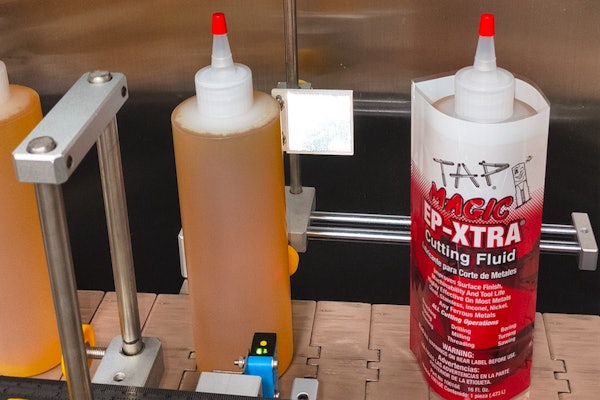When troubleshooting Continuous-Thread (C-T) closures, focus on three topics: application, torque, and composition of closure and container.
Application refers to the capping machines that mate the closure with the container. Problems with capping not only can negate the good performance of upstream stations but also those of downstream stations. The reason is straightforward—poor application means that the closure fails some fundamental functions of packaging, i.e., containment and protection.
Whereas various makes of capping machines differ in design and complexity, they share certain operational components. All must have the capability to feed, meaning getting closures to the station, involving elevators, hoppers, and conveyors. All must have the capability to sort—that is, to arrange closures single-file for individual placement onto containers. All must have chucks, the component that grips the closure and supplies the application torque. Beyond such shared components, capping machines differ in their speeds and their inspection capabilities, detecting and rejecting closures incorrectly applied.
Of the aforementioned operational components, the one most likely to be a problem source is the chuck. They become worn, reducing their ability to grip. They slip around the closure, unable to adequately apply torque. Chucks should be periodically inspected and replaced when needed. A more fundamental problem is that of the wrong type of chuck. A child-resistant, a dispensing, and a tamper-evident C-T closure might have the same dimensions, yet each might require a different chuck. The realization sometimes plays out with contract packagers that overapply their equipment.
Torque is important not only in its application, as precedingly explained, but also in its removal. It’s a rule-of-thumb that application torque, measured in inch-pounds, should be equivalent to one-half of the closure’s diameter, in millimeters. For example, a 24-millimeter closure should have an application torque of 12 inch-pounds and a removal torque of 6 inch-pounds.
Overtightening can cause threads to strip. Another result is closures that are cracked or otherwise damaged. One more possible result is damage to liners that are compressed beyond their recovery. Even in the absence of such compromising results, overtightening can cause the closure to be frustratingly difficult to open, which violates some fundamental functions of packaging, namely convenience and utility.
Under-tightening can cause loose closures, with leaks being the most foreseeable result. Loose closures tend to rattle under vibration imposed by conveyors and by vibration encountered during transit. Such rattling can further loosen already loose closures.
Editor’s note: For some prerequisite reading, bone up on previous discussions that Sterling Anthony has had on the topic of C-T closures, including this one from last month, called Continuous-Thread Closures. It goes over the basic properties of C-T closures, setting the stage and naming the terms needed for this column on trouble-shooting.
No rule-of-thumb can eliminate the possibility of overtightening nor of under-tightening. Once torque settings are made, they don’t always stay calibrated that way, even without intervention. So, an operator must stay aware of the telltale signs and readjust the torque setting downward or upward, as required.
Material composition and design of closure and container affect the compatibility between the two and what is required for an effective pairing. Closures can be made of metal, or more commonly, of plastic. Regarding the latter, the composition can be a thermoset, such as a phenolic, or a thermoform, such as polyethylene or polypropylene. Container composition possibilities include metal, glass, and plastic. Different combinations of closure material and container material yield different levels of friction, which, in turn, affects torque retention.
Materials aren’t necessarily homogenous. Instead, they can contain additives—such as slip agents—that influence friction. Other influencers, residing on surfaces, include lubricants and release agents, both from the manufacturing process.
Environmental factors, particularly temperature and humidity, can influence compatibility between closure and container. A polymer closure, for example, can soften if exposed to high temperatures during storage or during transit. In that scenario, an application torque can decrease due to the reduced friction between closure and container.
Although container finishes and C-T closures are specified in standardized nomenclature, their fit can be defective in terms of thread engagement. An example is a mismatch where the uppermost thread in the finish engages with the corresponding thread track in the closure in a way that leaves a gap where the inner surface of the closure and the top of the finish should meet.
We’ll conclude with brief mentioning of some standardized testing of C-T closures, their aim being to address problems proactively. ASTM D2063 and ASTM D7860 measure torque retention by non-mechanical and mechanical means, respectively. Other methods can be classified as static or dynamic, depending on what conditions they purport to simulate. Manufacturers and testing laboratories are the usual performers. Some type of testing, however, should be part of each user’s quality-assurance. It can be as simple as setting aside samples directly off the capping station and testing removal torque immediately on some and later on the rest, at spaced intervals.
Sterling Anthony, CPP, consults in packaging, marketing, logistics, and human-factors. A former faculty member at the Michigan State University School of Packaging, his contact info is:100 Renaissance Center, Box-176, Detroit, MI 48243; 313/531-1875; [email protected]
























